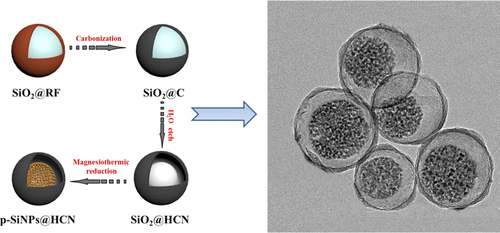当前位置:
X-MOL 学术
›
ACS Appl. Mater. Interfaces
›
论文详情
Our official English website, www.x-mol.net, welcomes your feedback! (Note: you will need to create a separate account there.)
Tunable Synthesis of Yolk–Shell Porous Silicon@Carbon for Optimizing Si/C-Based Anode of Lithium-Ion Batteries
ACS Applied Materials & Interfaces ( IF 9.5 ) Pub Date : 2017-11-17 00:00:00 , DOI: 10.1021/acsami.7b13035 Sichang Guo 1 , Xiang Hu 1 , Yang Hou 2 , Zhenhai Wen 1
ACS Applied Materials & Interfaces ( IF 9.5 ) Pub Date : 2017-11-17 00:00:00 , DOI: 10.1021/acsami.7b13035 Sichang Guo 1 , Xiang Hu 1 , Yang Hou 2 , Zhenhai Wen 1
Affiliation

|
Significant “breathing effect” calls for exploring efficient strategies to address the intrinsic issues of silicon anode of lithium-ion batteries (LIBs). We here report a controllable synthetic route to fabricate the silicon–carbon hybrids, in which porous silicon nanoparticles (p-SiNPs) are loaded in void carbon spheres by forming the yolk–shell p-SiNPs@hollow carbon (HC) nanohybrids tunable. A set of controlled experiments accompanying with systematic characterizations demonstrate that the void space and mass loading of Si can be adjusted in an effective way so that the nanostructure can be optimized with achieving improved electrochemical performance as anode of lithium-ion batteries (LIBs). The optimized p-SiNPs@HC nanohybrids show excellent performance as anode for Li-ion battery, delivering a capacity of more than 1400 mA h g–1 after 100 cycles at 0.2 A g–1 and 720 mA h g–1 at a high current density of 4 A g–1. The present work may provide us with an attractive and promising strategy for advancing Si-based anode materials due to advantages of tunable structure of silicon–carbon nanohybrids for optimizing electrochemical performance.
中文翻译:

卵壳多孔硅@碳的可调谐合成,以优化基于Si / C的锂离子电池阳极
重大的“呼吸效应”要求探索有效的策略来解决锂离子电池(LIB)硅阳极的内在问题。我们在这里报告了一条可控的合成路线,以制造硅碳杂化物,其中通过形成可调谐的卵黄壳p-SiNPs @空心碳(HC)纳米杂化物,将多孔硅纳米粒子(p-SiNPs)填充在空碳球中。一组受控实验以及系统表征表明,可以有效地调节Si的空隙空间和质量负载,从而可以优化纳米结构,并获得改善的锂离子电池(LIBs)阳极电化学性能。经过优化的p-SiNPs @ HC纳米杂化物表现出出色的性能,可作为锂离子电池的负极,提供超过1400 mA hg的容量-1 0.2 A G 100次循环后-1和720毫安汞柱-1在4甲g的高电流密度-1。由于硅碳纳米杂物的可调谐结构可优化电化学性能,因此本工作可能为我们提供一种有吸引力的且有前途的策略来推进基于硅的阳极材料。
更新日期:2017-11-19
中文翻译:

卵壳多孔硅@碳的可调谐合成,以优化基于Si / C的锂离子电池阳极
重大的“呼吸效应”要求探索有效的策略来解决锂离子电池(LIB)硅阳极的内在问题。我们在这里报告了一条可控的合成路线,以制造硅碳杂化物,其中通过形成可调谐的卵黄壳p-SiNPs @空心碳(HC)纳米杂化物,将多孔硅纳米粒子(p-SiNPs)填充在空碳球中。一组受控实验以及系统表征表明,可以有效地调节Si的空隙空间和质量负载,从而可以优化纳米结构,并获得改善的锂离子电池(LIBs)阳极电化学性能。经过优化的p-SiNPs @ HC纳米杂化物表现出出色的性能,可作为锂离子电池的负极,提供超过1400 mA hg的容量-1 0.2 A G 100次循环后-1和720毫安汞柱-1在4甲g的高电流密度-1。由于硅碳纳米杂物的可调谐结构可优化电化学性能,因此本工作可能为我们提供一种有吸引力的且有前途的策略来推进基于硅的阳极材料。


























 京公网安备 11010802027423号
京公网安备 11010802027423号